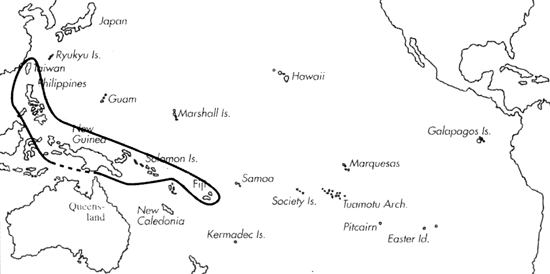Range: Taiwan to Philippines, Papua New Guinea, Solomon Is. and Fiji.
Description: Moderately small to large, moderately solid to solid. Last whorl narrowly conoid-cylindrical, conoid-cylindrical or ventricosely conical; outline convex at adapical third, less so or straight below. Shoulder subangulate or rounded. Spire low, outline concave to straight. Larval shell multispiral, maximum diameter about 0.7 mm. Teleoconch sutural ramps flat to slightly concave, with a pronounced subsutural ridge and 1 increasing to 6-8 spiral grooves; additional spiral striae on last ramp. Last whorl with variably spaced and wide axially striate spiral grooves on basal third to half; grooves separating broad ribbons adapically and narrower ribbons and ribs near base.
| Shell Morphometry | ||
|---|---|---|
| L | 30-109 mm | |
| RW | 0.12-0.55 g/mm | |
| RD | 0.48-0.61 | |
| PMD | 0.74-0.82 | |
| RSH | 0.05-0.11 | |
Last whorl beige to dark brown, sometimes shaded with pale violet, often with a narrow white or grey spiral band at shoulder and less frequently with irregularly arranged white to bluish grey axial streaks. Larval shell beige. Teleoconch sutural ramps white or grey to dark brown, occasionally shaded with violet, often bicoloured or maculated dark and light; colour of spire may contrast with colour of last whorl. Aperture white, sometimes tinged with brown or violet.
Periostracum dark brown, thin, opaque, and smooth.
Dorsum of foot white to beige, spotted with tan and brown except for anterior median area, with a dotted black pre-marginal line ending in anterior corners and a tan spot beneath the operculum. Sole of foot blending white and tan. Rostrum cream, dotted with dark brown except for tip. Tentacles white tipped with tan. Siphon immaculate white ventrally, grading to tan dorso- laterally, with transverse black mottling (Pl. 75, Fig. 33) (Chaberman, pers. comm., 1981).
Habitat and Habits: In 10- 30 m; on mud and muddy sand bottoms (Cernohorsky, 1964; Chaberman, pers. comm., 1981).
Discussion: C. radiatus is similar to C. parius, C. ochroleucus, C. cinereus form gubba and C. hyaena concolor. C. hyaena concolor differs in its usually more conical last whorl (PMD 0.81-0.89) and its angulate shoulder, in the absence of a pronounced subsutural ridge and the absence of ribbons at the base. For comparison with C. parius, C. ochroleucus and C. cinereus see the DISCUSSIONS of the latter species. There is a remarkable variability in adult size within C. radiatus. In the Solomon Is., adults are moderately small to medium-sized, while in Taiwan, Philippines and Papua New Guinea, the average adult size in most populations is 60-90 mm.

C. radiatus range map
This section contains verbatim reproductions of the accounts of 316 species of Conus from the Indo-Pacific region, from Manual of the Living Conidae, by Röckel, Korn and Kohn (1995). They are reproduced with the kind permission of the present publisher, Conchbooks.
All plates and figures referred to in the text are also in Röckel, Korn & Kohn, 1995. Manual of the Living Conidae Vol. 1: Indo-Pacific Region.
The range maps have been modified so that each species account has it own map, rather than one map that showed the ranges of several species in the original work. This was necessary because each species account is on a separate page on the website and not confined to the order of accounts in the book.